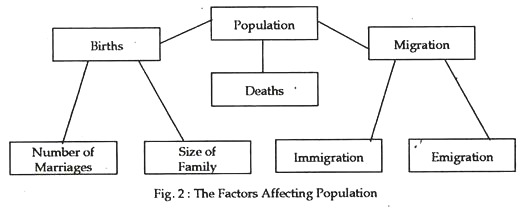In this article we will discuss about the supply of labour. Also learn about the determinants of supply of labour.
The aggregate supply of labour in an economy per period is not the same thing as the number of people belonging to that community. The term ‘supply of labour’ is used to measure the number of hours of work which is offered at given wage rates per period of time.
It is, therefore, determined by two things:
(1) The number of workers, and
ADVERTISEMENTS:
(2) The average number of hours each worker is willing to work.
Both the factors keep on changing over time. Over a long period of time the size of labour force is affected by the total population and its age, sex and geographical distribution. Changes in birth, death and marriage rates are therefore key influences. Two other influencing factors are rates of emigration and immigration, as is shown in Fig. 2.
ADVERTISEMENTS:
Fig. 2 shows that an increase or decrease of population during any period depends upon:
(a) The number of births;
(b) The number of deaths; and
(c) Migration.
ADVERTISEMENTS:
The difference between the birth rate and the death rate is called the rate of natural increase or decrease of the population.
Migration represents the net balance between the numbers of persons leaving the country (emigration) and those entering the country (immigration).
But, at a fixed point of time, these two factors depend on the following:
1. The Size of the Total Population:
This is the primary determinant of the total supply of labour. In fact, the size of the total population sets an upper limit to the supply of labour.
2. The Age Composition of the Population:
This factor takes into account the proportions of people belonging to different age groups. If most people are in the age group of 20-50, the supply of labour will be very high. If most people are in the age group of 45-65, the supply of labour will be low.
Thus, two countries may have the same total population, but the supply of labour is likely to vary due to differences in age composition. This is why most people in some advanced countries like France, Germany, Holland are now worried about the problem of ageing population. If there is zero population growth then after sometime the actual supply of labour will fall, because most people will gradually move into the age group of 50-70.
3. The Working Population:
ADVERTISEMENTS:
The supply of labour also depends on the proportion of working population in the total labour force. This partly depends on the minimum age at which a person can join the labour force and engage in full time employment. In some countries this factor is legally controlled. In other countries there are severe restrictions on the employment of child labour.
The term ‘working population’ refers to the number of people who are eligible for work and offer themselves for employment. As a proportion of the total population it will differ widely from country to country and period to period, depending on the levels of development.
4. The Working Week and Holidays:
Another important determinant of the supply of labour is the average number of hours each person works. Let us suppose, for example, that two countries have the same number of workers, but that in one the working hours are 40 per week and in the other 48 hours per week.
ADVERTISEMENTS:
Obviously, the latter country has more labour power. However, since long working hours reduce efficiency of labour, in modern times, working hours are determined by the government at reasonable levels in all civilized countries.
In India, the Factories Act was passed in 1948 to regulate the conditions of work, including the maximum number of hours one is supposed to work per day or per week.
Of course, if workers voluntarily work for longer hours they will receive extra payment. Other things remaining the same, the shorter the working week the smaller the total supply of labour. This means that, a fall in the number of hours worked per week or an extension of the annual holiday period will lead to a fall in the supply of labour.
5. Remuneration:
ADVERTISEMENTS:
The reward or price that is paid to labour in return for the services it performs is known as wage or salary. A man’s wages are associated with his productivity or efficiency and this, in its turn, depends on a variety of factors including the education and job training he has received, his innate skill and the extent to which he is motivated to put his best effort in the work he is doing. In general, the supply of labour varies directly with wages and compensation. Normally, when wages are relatively low, increases in wages will tend to lead to an increase in the supply of labour.
However, as wages continue to rise, a stage ultimately comes when higher wages (incomes) make leisure more attractive. When incomes are relatively high, therefore, higher wage rates may actually lead to a fall in the number of hours worked (and thus in the amount of labour offered by an individual worker). This is why the supply curve of labour bends back to the left and this is often cited as an important exception to the (empirical) law of supply.
